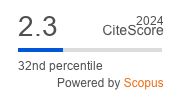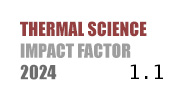ABSTRACT
In both turbulent and laminar pipe flows, we were able to accurately forecast the beginning range of the convective thermal transferring coefficients of Al2O3 magnetized nanofluids using machine learning approaches. The simulations utilized two machine learning techniques: radial basis function-backpropagation (RB) and multiple linear regression analysis. First, we used multiple linear regression analysis to fit the polynomial equation. Afterwards, grid search cross-validation was employed to determine the optimal RB model with six hidden layer neurons. To evaluate the RB model, we compared numerical patterns of the parameters used to measure accuracy. The regression coefficient and mean square error were the most commonly utilized parameters in Reynolds number mass percentage simulations, R2. In the case of a laminar flow, these numbers were found to be 0.99994 and 0.34, respectively. Additionally, the results for laminar flow conditions using Reynolds number-magnetic field strength simplification were ideal, with an mean square error of 3.85 and an R2 value of 0.99993. By comparing the predicted values with the experimental results visually using 3-D smoothed surface plots, we were able to further prove that the model was valid and accurate. These revolutionary findings could spark new developments and encourage substantial improvements in nanotechnology and machine intelligence. These findings are an important asset for driving future research and development, which in turn makes significant contributions to the ever-expanding frontiers of these innovative fields.
KEYWORDS
PAPER SUBMITTED: 2023-03-10
PAPER REVISED: 2023-09-15
PAPER ACCEPTED: 2023-10-21
PUBLISHED ONLINE: 2024-02-18
THERMAL SCIENCE YEAR
2024, VOLUME
28, ISSUE
Issue 1, PAGES [731 - 741]
- Zhang, Y., Xu, X., Machine Learning Specific Heat Capacities of Nanofluids Containing CuO and Al2O3, AIChE Journal, 67 (2021), 9
- Mukesh Kumar, P. C., Kavitha, R., Regression Analysis for Thermal Properties of Al2O3/H2O Nanofluid Using Machine Learning Techniques, Heliyon 6 (2020), 6
- Mackolil, J., Mahanthesh, B., Time-Dependent Non-Linear Convective Flow and Radiative Heat Transfer of Cu-Al2O3-H2O Hybrid Nanoliquid with Polar Particles Suspension: a Statistical and Exact Analysis, Bionanoscience, 9 (2019), 4, pp. 937-951
- Chokkiyee, M. K. P., et al., Predictive Analysis of Heat Transfer Characteristics of Nanofluids in Helically Coiled Tube Heat Exchanger Using Regression Approach, Thermal Science, 24 (2020), 1B, pp. 505-513
- Adun, H., et al, An Experimental Investigation of Thermal Conductivity and Dynamic Viscosity of Al2O3-ZnO-Fe3O4 Ternary Hybrid Nanofluid and Development of Machine Learning Model, Powder Technol, 394 (2021), 4, pp. 1121-1140
- Mukesh Kumar, P. C., Kavitha, R., Prediction of Nanofluid Viscosity Using Multilayer Perceptron and Gaussian Process Regression, Journal Therm. Anal. Calorim., 144 (2021), 4, pp. 1151-1160
- Zhou, J., et al., Numerical Investigation, Environmental Consideration, and the Use of Machine Learning in Optimizing the Dimensions of a Rectangular Blade Between two Blades in the Presence of a Magnetic Field (Two-Phase Method), Eng. Ana.l Bound Elem., 149 (2023), Mar., pp. 71-85
- Saha G., aPaul, M. C., Analysis of Heat Transfer and Entropy Generation of TiO2-Water Nanofluid-Flow in a Pipe under Transition, Procedia Engineering, 105 (2015), pp. 381-387
- Syah, R., et al., Numerical Investigation of Nanofluid-Flow Using CFD and Fuzzy-Based Particle Swarm Optimization, Sci. Rep., 11 (2021), 1
- Zhou, J., et al., Numerical Study of Mixed Convection Flow of Two-Phase Nanofluid in a 2-D cCvity with the Presence of A Magnetic Field By Changing the Height of Obstacles with Artificial Intelligence: Investigation of Entropy Production Changes and Bejan Number, Eng. Anal Bound. Elem., 148 (2023), Apr., pp. 52-61
- Shah, M. A., et al., Use of Neural Network and Machine Learning in Optimizing Heat Transfer and Entropy Generated in a Cavity Filled Wwth Nanofluid under the Influence of Magnetic Field: A Numerical Study, Eng. Anal. Bound. Elem., 139 (2022), June, pp. 113-131
- Mesgarpour, M., et al., An Investigation of the Thermal Behavior of Constructal Theory-Based Pore-Scale Porous Media by Using a Combination of Computational Fluid Dynamics and Machine Learning, Int. J. Heat Mass Transf., 194 (2022), 123072
- Ozgirgin Yapıcı, E., et al., Analysis of Heat Transfer Enhancement of Passive Methods in Tubes with Machine Learning, ARCHIVE Proceedings of the Institution of Mechanical Engineers, Part C, Journal of Mechanical Engineering Science 1989-1996, 203-210, 2023
- Jery, A. E., et al., Numerical Simulation and Artificial Neural Network Prediction of Hydrodynamic and Heat Transfer in a Geothermal Heat Exchanger to Obtain the Optimal Diameter of Tubes with the Lowest Entropy Using Water and Al2O3/Water Nanofluid, Geothermics, 107 (2023), 102605
- Alimoradi, H., et al., A Parametric Study of Subcooled Flow Boiling of Al2O3/Water Nanofluid Using Numerical Simulation and Artificial Neural Networks, Nanoscale and Microscale Thermophysical Engineering, 26 (2022), 2-3, pp. 129-159
- Zhang, R., et al., Experimental Investigation and Machine Learning Modelling of Heat Transfer Characteristics for Water Based Nanofluids Containing Magnetic Fe3O4 Nanoparticles, Mater Today Commun., 36 (2023), 106798
- Rahnama, Z., Ansarifar, G. R., Predicting and Optimizing the Thermal-Hydraulic, Natural Circulation, And Neutronics Parameters in the Nuscale Nuclear Reactor Using Nanofluid As a Coolant Via Machine Learning Methods through GA, PSO, and HPSOGA Algorithms, Ann Nucl. Energy, 161 (2021), 108375
- Sahebi, S. A. R., et al., On the thermal Performance of Nanofluid over a Cylinder Within a Confined Channel: The Splitter Effect, Case Studies in Thermal Engineering, 49 (2023), 103275
- Ahmed, Z., et al., The Al2O3-CO2 Nanofluid Transport Properties: A Molecular Dynamics Study and Machine Learning Predictive Modelling, Heat Transfer Engineering, 44 (2023), 19, pp. 1747-1761
- Shahsavar, A., et al., Investigation on Two-Phase Fluid Mixture Flow, Heat Transfer and Entropy Generation of a Non-Newtonian Water-CMC/CuO Nanofluid Inside a Twisted Tube wwith Variable Twist Pitch: Numerical and evolutionary Machine Learning Simulation, Eng. Anal. Bound. Elem., 140 (2022), July, pp. 322-337
- Girimurugan, R., et al., Application of Deep Learning to the Prediction of Solar Irradiance through Missing Data, International Journal of Photoenergy, 2023 (2023), ID4717110
- Alghamdi, W., et al., Turbulence Modelling through Deep Learning an In-Depth Study of Wasserstein GAN, Proceedings, 4th Int. Conf. on Smart Elec. and Communication, Trichy, India
- Fuxi, S., et al., Artificial Neural Network Modelling to Examine Spring Turbulators Influence on Parabolic Solar Collector Effectiveness with Hybrid Nanofluids, Eng. Anal Bound. Elem., 143 (2022), Oct., pp. 442-456

